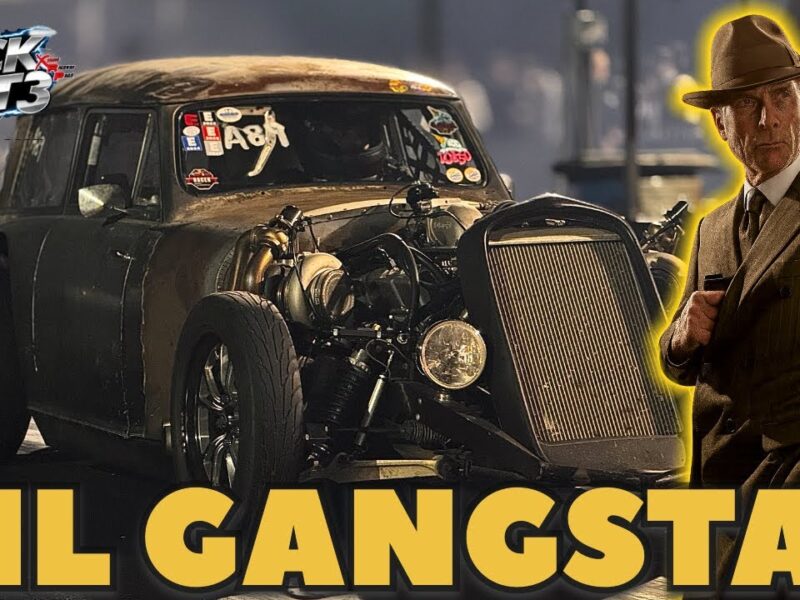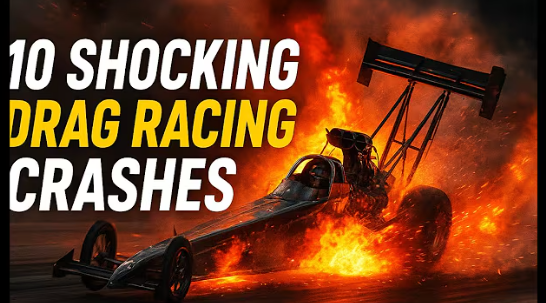Take a look at these Drag Racing Biggest Crashes And Explosions!
Drag racing sits at the intersection of horsepower and chaos.
It’s a sport where 11,000-horsepower engines scream, superchargers strain to the edge of destruction, and cars streak down the track faster than the human mind can process.
But when the limit is pushed too far, things can go catastrophically wrong.
These are the biggest crashes and explosions that remind us why drag racing is both exhilarating and terrifying.
1. The Funny Car Fireballs That Turn Night Into Day
Funny Cars are ticking bombs on wheels.
They’re fueled by nitromethane — a liquid more explosive than people realize — and when it goes wrong, it goes VERY wrong.
Blown superchargers
Firewall failures
Nitro detonations
Bodies launching sky-high
Some explosions are so massive they rip the entire carbon-fiber body off the chassis, sending it flying like a paper cup.
Fans don’t just watch these moments — they feel them.
2. Don Garlits’ 1970 Transmission Explosion — The Crash That Changed Everything
One of the most violent crashes in NHRA history.
A clutch explosion blew Garlits’ dragster in half, shredding his foot and nearly ending his career.
Instead, he created the rear-engine dragster — the design used in Top Fuel today.
This crash didn’t just shake the sport.
It reinvented it.
3. Scott Kalitta’s Tragic Funny Car Explosion (2008)
A nitro explosion blew Kalitta’s engine apart at 300+ mph, sending his car through the shutdown area and over the sand trap.
The crash was fatal — and it forced NHRA to shorten nitro racing to 1,000 feet for safety.
It remains one of the darkest moments in drag racing history.
4. John Force’s 2007 Nightmare Crash
John Force collided with Kenny Bernstein after his car exploded and crossed lanes.
The wreck broke:
-
his legs
-
his arms
-
fingers
-
bones he didn’t even know he had
But he survived — and returned to racing.
Few drivers have come back from something so violent.
5. Larry Dixon’s Car Splitting in Half (2015)
In one of the most shocking drag racing visuals ever captured, Larry Dixon’s Top Fuel dragster snapped into two pieces mid-run.
The front half shot into the air.
The rear half stayed on the track.
It looked impossible.
But it happened — and it forced NHRA to radically update chassis certification rules.
6. The Blowovers — When Dragsters Become Airplanes
Blowovers are among the most spine-chilling events in racing.
A car goes light.
Aerodynamics shift.
And suddenly — it lifts off like a fighter jet.
Cars flipping backward at 250–300 mph became too common in the early 2000s until new aero rules and front-wing designs reduced the danger.
Still, every time a dragster noses up, fans freeze.
7. The Parachute Failure Disasters
At 300 mph, a car needs parachutes.
Brakes alone won’t cut it.
But when a chute doesn’t deploy?
The dragster becomes a missile.
Drivers have blasted through:
-
sand traps
-
nets
-
barriers
-
fences
Often ending in fiery, devastating collisions.
Parachute and stopping-system rules have since become some of the strictest in NHRA.
8. Nitro Engine Explosions at the Hit
The launch is the most dangerous part of a run.
If the mixture is wrong, the spark is late, or the blower overpowers the cylinders, a nitro engine can explode before the 60-foot mark.
Some engines blow with such violence that:
-
connecting rods fly out
-
fire shoots from every side
-
bodies erupt off the frame
-
cars veer instantly into walls
The violence is unmatched in motorsports.
9. Side-by-Side Crashes — The Worst Case Scenario
Two cars losing control at once is the nightmare situation.
A lane-crossing incident in the wrong moment can trigger:
-
door-to-door collisions
-
full-speed impacts
-
fiery chain reactions
Several Pro Mod and Funny Car crashes over the years have shown how razor-thin the margin is when two 200–300 mph cars are inches apart.
10. The Crashes That Created Safety Innovations
Every giant explosion or catastrophic crash pushes the sport forward.
Because of these disasters, drag racing now has:
✔ Stronger monocoque chassis
✔ HANS devices
✔ SFI-approved suits
✔ Improved parachutes
✔ Multiple fire systems
✔ Better rear wing engineering
✔ Strict track-prep rules
✔ Full-time safety teams
✔ High-speed crash data logs
Drag racing gets safer because danger forces evolution.
Final Thoughts: The Beauty and Brutality of Speed
Drag racing is pure adrenaline — a sport built on bravery, engineering, and the willingness to stare danger in the face at 300 mph.
But the biggest crashes and explosions remind us that the margin between perfection and catastrophe is razor-thin.
Fans watch for the thrill.
Drivers accept the risk.
And the sport continues to evolve — forged by fire, rebuilt by innovation, and fueled by the passion of those who refuse to lift.


